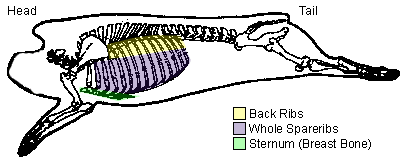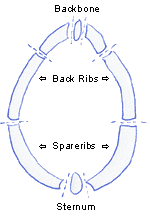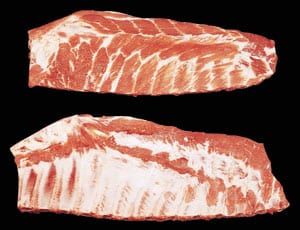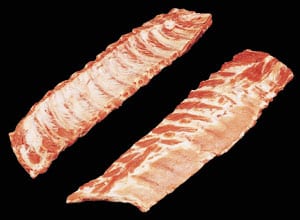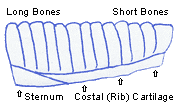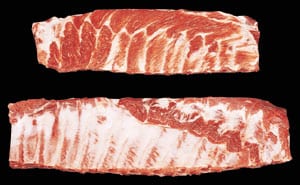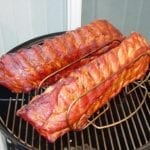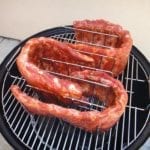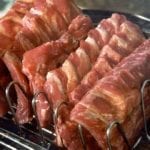In this topic:
- Spareribs vs. Loin Back Ribs
- St. Louis Style Spareribs
- Slab Defined
- What To Look For When Buying Ribs
- Beware Of “Enhanced” Ribs
- Servings Per Slab
- Where To Buy Ribs
- Prepping Ribs
- How To Tell When Ribs Are Done
- Increasing Rib Cooking Capacity
- More Information About Pork Ribs
- More Pork Rib Links On TVWB
There are two common types of pork ribs—spareribs and loin back ribs. Country-style ribs are either split pork chops from the blade end of the loin, or they’re cut from the shoulder closest to the loin. Good eating, but not true ribs to most people.
Spareribs vs. Loin Back Ribs
Spareribs come from the belly of the hog, where bacon comes from. They are large in size (2-4 pounds or more), are very meaty, and are somewhat less tender than loin back ribs. Spareribs tend to have more fat, more flavor, and cost less per pound than loin back ribs.
Loin back ribs come from the loin of the hog, where pork chops come from. You’ll sometimes see them called baby back ribs or loin ribs in the grocery store. They are small in size (1-1/4 to 2-1/4 pounds or more) and are less meaty, less fatty, and more tender than spareribs. Because of their smaller size, loin back ribs cook faster than spareribs. They are one of the most expensive cuts of meat from the hog due to high consumer demand.
People often use the terms “baby back ribs” and “back ribs” interchangeably. However, some in the pork industry suggest that only loin back ribs weighing less than 1-3/4 pounds per slab should be called “baby back”.
Figure 1 shows a side view of a hog and the relationship between these two types of ribs. Figure 2 shows a cross-section of the ribcage and the locations of the ribs, backbone, and sternum. Note that the dashed lines indicate where the bones are cut to produce each type of rib.
Photo 1 shows two slabs of whole, untrimmed spareribs. The top slab is facing meat-side up, the bottom slab bone-side up. Photo 2 shows two slabs of loin back ribs. The left slab is facing bone-side up, the right slab meat-side up.
St. Louis Style Spareribs
Spareribs are sold as whole untrimmed slabs or as St. Louis Style spareribs. A whole slab of spareribs will have part of the sternum (breast bone) still attached with a strip of meat and costal (rib) cartilage along the edge of the slab, plus a flap of meat attached to the bone side of the slab, known as the skirt. This is how you will often find spareribs sold at wholesale warehouse stores or butcher shops.
Figure 3 shows how these parts of the sparerib relate to one another, as viewed from the meat side of the slab. Note that the skirt is not visible in this view, since it’s on the other side of the slab.
If you cut away the sternum, cartilage, and skirt, you have a St. Louis Style sparerib. The result is a slab of ribs similar in appearance to loin back ribs. The meat that’s trimmed away in the process—sometimes called “rib tips” or “brisket”—can be cooked separately for a tasty snack.
Photo 3 shows two slabs of St. Louis style spareribs. The top slab is facing meat-side up, the bottom slab bone-side up.
It’s easy to buy whole spareribs and trim them St. Louis style yourself. You’ll find a detailed description of how to do this in Pork Sparerib Preparation.
Slab Defined
Pork ribs are sold in slabs. Depending on the breed, a pig will have 15-16 rib bones. During butchering, 2-3 bones are left in the shoulder portion and a scrawny bone or two may be trimmed off at the discretion of the butcher. For both spareribs and loin back ribs you buy in the store, you should expect a whole slab of ribs to contain 10-13 bones. Less than 10 bones and you’ve got what’s known as a “cheater” rack of ribs.
The size and weight of a slab is based on several factors, including the age and size of the hog (larger, heavier slabs tend to come from older hogs) and how the slabs were processed (for example, a supplier may offer loin back ribs in 3-3/4″ and 5-1/2″ widths).
You may hear terms like “1-1/4 to 1-1/2” or “3-1/2 and down” used to describe ribs. This is industry jargon for the weight ranges in which slabs are commonly sold. The term “1-1/4 to 1-1/2” refers to slabs of loin back ribs weighing 1-1/4 pounds to 1-1/2 pounds. “3-1/2 and down” refers to slabs of spareribs weighing 3-1/2 pounds or less.
Common ranges for spare ribs are “3-1/2 and down”, “3 to 5”, and “5 and up”; for loin back ribs, “1-1/4 to 1-1/2”, “1-3/4 and down”, “1-3/4 to 2-1/4”, and “2-1/4 and up”. While these terms are commonly used by meat suppliers at the wholesale level, you won’t see them used in retail stores.
Sometimes slabs of St. Louis Style spareribs and loin back ribs are cut in half at the supermarket for packaging convenience or to allow shoppers to buy smaller quantities. I like to buy and cook whole slabs whenever possible. I find that it’s easier to prep and cook a small number of large pieces than a large number of small pieces. I also find that the end pieces can dry out, and you have fewer end pieces if you’re cooking whole slabs.
What To Look For When Buying Ribs
Choose slabs with good meat coverage over the bones and no large areas of surface fat. Avoid “shiners”—slabs where the meat has been cut too close to the bone. These exposed bones may fall out during cooking.
For best quality, avoid buying ribs that are frozen or have been previously frozen, if you can. This is not always possible, and sometimes it’s impossible to know if ribs have been previously frozen. In fact, some people feel there’s not much difference in quality in the finished product, whether using fresh or frozen ribs. However, if you have a choice, I think fresh is best.
Cryovac packages containing 1-3 slabs of ribs have usually not been frozen, but there are exceptions and they do sometimes turn up frozen in grocery stores. Ribs sold in loose slabs by the case (not in Cryovac) are commonly sold frozen.
In any event, reject ribs that are discolored or that have dried-out edges, an indication of freezer burn.
You may notice a slight odor when opening the Cryovac packaging. This odor is normal and should dissipate after a few minutes. If the odor is a strong, putrid smell that lasts longer than 10 minutes, the meat is probably spoiled and should be returned to the store for a refund.
You may also notice some liquid in the bottom of the Cryovac packaging. This liquid is called “purge” in the meat industry. It is normal for meat to release a modest amount of liquid as it sits in the packaging. However, a large amount of liquid is an indication of excessive storage time, improper storage temperature, or previously frozen meat.
In terms of size and weight of slabs, experiment to find out what you like. I like to buy smaller slabs, around 2 pounds each, believing that there’s a higher ratio of meat to bone in smaller slabs. Some people like larger slabs. Try different sizes and make your own judgment. But remember, every slab is unique. You can line up several slabs of similar size and weight, cook them all the same way, and find each one different in terms of tenderness. That’s part of the fun and variability of barbecue!
Beware Of “Enhanced” Ribs
More and more often, the fresh pork products sold by supermarket chains and discount retailers have been “enhanced” with a solution of water, sodium phosphate, and flavorings. The pork industry believes that consumers like enhanced pork products because they are juicier and more tender even when overcooked.
Some people describe the taste of enhanced ribs as artificial or hammy. Some unsuspecting buyers apply a typical salt-laden rub to these ribs and then wonder why they ended up tasting too salty—not realizing that the ribs had already been pumped full of salt and other flavorings.
The point is simple: Make sure you know what you’re buying. See Enhanced Meat for more information on this trend and how you can identify enhanced pork products in the supermarket.
I prefer to use non-enhanced ribs so I can season them the way I like. If you use enhanced ribs, make sure to cut back on the salt in the rub you apply.
Servings Per Slab
On average, you will get 2-4 servings per slab of spareribs and 1-2 servings per slab of loin back ribs. A lot depends on whether you’re serving another barbecue meat along with the ribs, how many side dishes you’re offering, how hungry your guests are, how many football linebackers you’ve invited over, and how you present the ribs to your guests.
If you want to discourage guests from loading up on too many ribs at once, cut them into individual bones and place them at the end of the buffet line. People will load-up their plates with side dishes before getting to the ribs and then take only the number of ribs they want.
Where To Buy Ribs
You can find pork ribs in most supermarkets, butcher shops, and wholesale warehouse stores. In the supermarket you may find brand-name ribs neatly trimmed and individually packaged in Cryovac, or no-name ribs cut in half and packaged on Styrofoam trays. It can be difficult to tell exactly what you’re getting when ribs are packaged using these two methods.
At high-end grocery stores and butcher shops, you’ll find ribs unpackaged in the display case. This makes it easy for you to select the best looking slabs. Of course, you’ll pay a higher price for this privilege.
The advantages of buying ribs at a wholesale warehouse store are low prices and more meat left on the bone compared to slabs you’ll find in supermarkets and butcher shops. If you like large, meaty slabs of “dinosaur ribs”, you’ll find them here. The disadvantages are that you can’t normally buy individual slabs of ribs, you can’t get a good look at them through the Cryovac, and you may find large areas of surface fat and some scrappy looking bits at the end of the slabs. However, you can easily remove the surface fat and scrappy bits when preparing the ribs before cooking.
If you need a large quantity of ribs, you can buy them by the case from a local meat supplier. This is where your knowledge of terms like “1-1/4 to 1-1/2” and “3-1/2 and down” will come in handy, because that’s how you’ll order your ribs. A meat supplier will offer a variety of sizes, weights, and brands of ribs. You usually have to place your order a few days in advance. You will find wholesale meat suppliers listed in the Yellow Pages, and most will sell to retail customers like you and me if you ask nicely, especially if you tell them you’re a barbecue enthusiast.
To give you an idea of what you can expect if you buy a case of ribs…I purchased a case of “1-1/4 to 1-1/2” loin back ribs from a meat supplier and cooked them on four WSMs (see Barbecuing With Friends). That case weighed about 35 pounds and contained 21 slabs of ribs.
Finally, don’t assume that you’ll get a higher quality slab of ribs at a high-end supermarket or butcher shop. Ribs from well-known national brands like IBP and Swift, as well as ribs from small regional producers, are found in supermarkets, high-end grocery stores, butcher shops, and wholesale warehouse stores alike.
Most stores don’t advertise the brand of ribs they sell and they tend to change brands frequently depending upon fluctuations in price and availability. Often, it’s best to just shop for ribs by price. For example, during the July 4th holiday in 2000, I noticed that the Cryovaced loin back ribs being sold at a high-end grocery store were the exact same brand and size of ribs being sold at Costco—but they cost $2 per pound more at the grocery store.
Prepping Ribs
If you want to make the best barbecued ribs, there are a few simple steps you should take to prep the ribs. It won’t take a lot of time or effort, and you will notice the difference in the final product.
Prepping ribs consists of three steps:
- Removing the membrane
- Trimming the slab
- Removing excess fat
See More Pork Rib Links On TVWB for detailed descriptions and photos of preparing loin back ribs and spareribs.
Removing the membrane from the bone-side of the slab is one of the secrets of tender ribs. Smoke and seasonings will not penetrate the tough membrane, and leaving it intact makes for tough eating. The membrane is thickest toward the backbone of the hog and gets very thin toward the belly. This means that loin back ribs will have a thicker, tougher membrane than spareribs. The density of the membrane is also influenced by the age and size of the hog.
Sometimes you will see recipes that call for rinsing ribs under running water or with vinegar before cooking. Do you think barbecue restaurants rinse the thousands of slabs of ribs they cook each year? No, they don’t, and you don’t need to, either.
How To Tell When Ribs Are Done
Ribs are done when they reach an internal temperature of 180-195°F, but due to their thin shape and number of bones this can be difficult to measure. If you have a high quality instant-read thermometer with a needle-thin probe like the ThermoWorks Thermapen, you can insert it into the meat through the side of the slab between the bones and get some sense of internal temperature. However, it’s more common for pitmasters to look at the physical characteristics of ribs to determine doneness than to try to measure internal temperature.
The best way to tell whether ribs are cooked to perfection is to use the tear test. Take hold of two adjacent bones toward the middle of the slab and pull them away from each other. If the meat offers a bit of resistance but then tears easily, you know the ribs are done just right. This method works for both full and partial slabs of ribs.
Another approach for full slabs of ribs is the bend test. Slip a pair of tongs under the end of the slab, grabbing the slab a few bones in from the end, and give a gentle bounce. If the ribs bend and the surface of the meat cracks almost to the point of the slab breaking apart, the ribs are done. If you can’t pickup the ribs without the slab breaking immediately, they are overdone.
Other indicators of doneness, such as how far the meat has pulled down the bone or whether a toothpick passes easily through the meat, are not as reliable as the tear or bend tests.
As for eating ribs, the bite test is the gold standard for KCBS Certified Barbecue Judges. A bite taken from the middle of an individual rib should be moist and have good texture (not mushy). The meat should come cleanly off the bone, leaving behind a well-defined bite mark, and the bone will turn dry almost immediately. Ribs that are “fall off the bone” tender may be enjoyable when eaten at home but are considered overcooked in barbecue competitions.
Increasing Rib Cooking Capacity
Here are two techniques that allow you to cook more ribs in your Weber Smokey Mountain Cooker.
Rib Racks
To get more ribs in your cooker, try using a rib rack. The Weber 6605 Original Rib Rack is a quality rib rack that works well on the WSM. Another good rack is the Char-Broil 4740 Potato-and-Rib Rack (middle photo). The rib racks shown in Photos 4 and 6 have been discontinued.
A rib rack holds slabs on edge. You can leave the slabs whole and if they are too long, they can be wrapped across alternating slots. Of course, slabs can also cut into smaller portions and placed into slots.
Most rib racks have 4-6 slots. You may be able to squeeze in even more slabs by leaning them against the front, back or sides of the rib rack.
Rolling Ribs
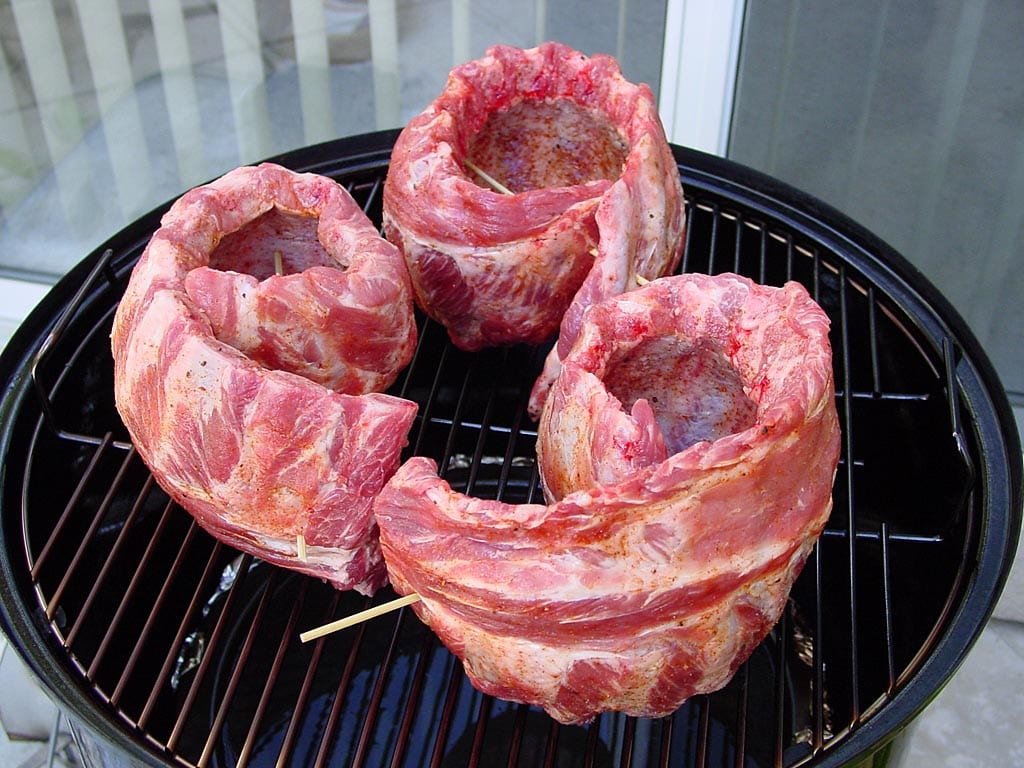
To fit more full-length slabs of ribs in your cooker, try rolling them. Roll each slab into a loose circle, overlapping the ends a bit. Secure the rolled slabs using skewers or kitchen twine, then stand the ribs on edge on the cooking grate. Using this method, you can fit 3-4 slabs of loin back ribs on each cooking grate. Try this method with spareribs, too.
Bamboo skewers work well for rolled ribs and are very inexpensive. Due to the “low and slow” heat of barbecuing, they don’t need to be soaked in water before use. Once inserted through the slab, trim any excess with kitchen shears for easier placement of the slabs in the cooker.
Rolled ribs tend to hold their shape after cooking, so you won’t end up with nice flat slabs. If you try to flatten the slab, the meat will usually tear, so just cut the slabs into short sections or individual bones for presentation to your guests.
With rolled ribs, any areas of meat that touch one another during cooking won’t have that nice brown color and smoke penetration like the rest of the meat. To avoid this, arrange the ends of each slab on the skewer so they won’t touch during cooking. If you end up with splotchy areas of meat, just apply sauce generously to both sides of the slab and no one will notice the difference.
More Information About Pork Ribs
More Pork Rib Links On TVWB
- Basic Baby Back Ribs
- Easy Baby Back Ribs
- Best Ribs In The Universe: Baby Back Ribs By The Legendary Mike Scrutchfield
- Baby Back Ribs – Dry Ribs
- Spareribs – Sugarless Texas Sprinkle
- Spareribs – 3-2-1 Method
- Rib Sandwich
- Pork Loin Back Rib Preparation
- Pork Sparerib Preparation
Photographs of sample loin back ribs, spareribs, and trimmed spareribs: 2003 by National Pork Board.
More Pork Facts & Info
Pork Grades
Pork processing plants pay to have pork graded for quality on a voluntary basis. There are only two grades: “acceptable” and “utility”. The grade is determined by how much lean meat is on the carcass. “Acceptable” is the only grade of fresh pork sold in supermarkets in the U.S. “Utility” grade pork is used mainly in processed products.
Antibiotics and Hormones
Antibiotics are administered to hogs to prevent or treat diseases. Before a hog can be legally slaughtered, a period of time must pass (the “withdrawal” period) to allow these substances to leave the animal’s system so there won’t be any residue in the meat.
In the U.S., hormones are not used in the production of hogs.
Pork Goes On A Diet
In the 1970’s, the average hog weighed about 300 pounds when slaughtered. Today, pork is produced from young animals (6-7 months old) averaging 175-240 pounds. Muscles are larger and leaner, and back and rib fat is considerably thinner. In fact, pork is about 50% leaner today than it was in 1975.
Pork is nutrient dense, provides essential vitamins like B1, B2, B6, and B12, and is a good source of iron and zinc. A 3 ounce portion of lean cooked pork contains about 200 calories, 25 grams of protein, 9 grams of fat, and 70 mg of cholesterol.
Dressed Out
When dressed out, today’s 240 pound hog will end up as a 180 pound carcass, rendering about 105 pounds of lean pork.
Is Pork Really “The Other White Meat”?
No, pork is classified as red meat, just like other livestock animals such as beef, veal, and lamb. This is because pork contains more myoglobin than poultry or fish. Myoglobin is the protein in meat that hold oxygen in muscles, and the amount of myoglobin in muscle determines the color of the meat.
Fresh pork does turn a light color when cooked, but it is still a red meat.
Trichinosis
Trichinosis has been virtually eliminated in pork produced in the United States. The few cases reported each year come mostly from homegrown hogs or game animals like bear or wild boar.
While you may want to barbecue a Boston butt to 200°F or higher for great pulled pork sandwiches, it’s not necessary to do so for food safety. Trichinella spiralis, the trichinosis parasite, is destroyed at a temperature of 137°F. To be safe, pork products should be cooked to at least 148°—a medium degree of doneness with the meat still noticeably pink.
Content inspired by The Complete Meat Cookbook by Bruce Aidells and Denis Kelly and material from the USDA Food Safety and Inspection Service.

